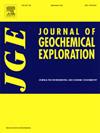The use of EDTA leaching method to predict arsenic and antimony Neutral Mine Drainage from the Eleonore tailings
IF 3.4
2区 地球科学
Q1 GEOCHEMISTRY & GEOPHYSICS
引用次数: 0
Abstract
The prediction of neutral mine drainage (NMD) is difficult using classical kinetic techniques due to the sorption and precipitation processes that retain the contaminant within the material, hiding the actual geochemical behaviour. A method for NMD prediction using sorption experiments and modified kinetic experiments with a complexing agent such as ethylenediaminetetraacetic acid (EDTA) was developed to predict metal leaching in mine waste. The objective of this study was to assess the applicability of the leaching procedure to oxyanions such as As and Sb as well as the evolution of the risk of Eleonore mine tailings towards As and Sb leaching in the long-term. The study found that the Eleonore tailings contained 527 mg/kg of As and 59 mg/kg of Sb, mostly found within löllingite and arsenopyrite. The leaching of As and Sb through complexation with EDTA was found to be effective in kinetic experiments for prediction purposes, despite EDTA's classification as a cation complexing agent. The tailings sorption capacity for As was estimated to be between 43 and 76 mg/kg. By comparing the sorption capacity and the metalloid content, the ratio sorption/metalloid content was found to be below 1 (0.07–0.13), indicating a high risk towards NMD. Furthermore, no notable change in sorption capacity was observed over the course of the column experiments, suggesting that sorption is unlikely to influence the As leaching dynamic. However, it is probable that As retention in the tailings is not primarily driven by sorption; given the high iron (Fe) loadings, coprecipitation may be the dominant mechanism.
EDTA浸出法预测Eleonore尾矿中砷锑中性矿水
由于吸附和沉淀过程将污染物保留在材料中,隐藏了实际的地球化学行为,因此使用经典的动力学技术很难预测中性矿井排水(NMD)。建立了以乙二胺四乙酸(EDTA)为络合剂的吸附实验和修正动力学实验相结合的NMD预测方法,用于预测矿山废弃物中的金属浸出。本研究的目的是评价该浸出工艺对砷、锑等氧离子的适用性,以及Eleonore矿尾矿对砷、锑的长期浸出风险演变。研究发现,Eleonore尾矿中As含量为527 mg/kg, Sb含量为59 mg/kg,主要存在于löllingite和毒砂中。尽管EDTA被归类为阳离子络合剂,但在动力学实验中,EDTA络合对As和Sb的浸出是有效的。尾矿对砷的吸附量在43 ~ 76 mg/kg之间。通过对吸附量和类金属含量的比较,发现吸附量与类金属含量之比小于1(0.07-0.13),表明具有NMD的高风险。此外,在整个柱实验过程中,没有观察到吸附能力的显著变化,这表明吸附不太可能影响As浸出动态。然而,尾矿中砷的保留可能主要不是由吸附驱动的;考虑到高铁(Fe)负载,共沉淀可能是主要的机制。
本文章由计算机程序翻译,如有差异,请以英文原文为准。
求助全文
约1分钟内获得全文
求助全文
来源期刊

Journal of Geochemical Exploration
地学-地球化学与地球物理
CiteScore
7.40
自引率
7.70%
发文量
148
审稿时长
8.1 months
期刊介绍:
Journal of Geochemical Exploration is mostly dedicated to publication of original studies in exploration and environmental geochemistry and related topics.
Contributions considered of prevalent interest for the journal include researches based on the application of innovative methods to:
define the genesis and the evolution of mineral deposits including transfer of elements in large-scale mineralized areas.
analyze complex systems at the boundaries between bio-geochemistry, metal transport and mineral accumulation.
evaluate effects of historical mining activities on the surface environment.
trace pollutant sources and define their fate and transport models in the near-surface and surface environments involving solid, fluid and aerial matrices.
assess and quantify natural and technogenic radioactivity in the environment.
determine geochemical anomalies and set baseline reference values using compositional data analysis, multivariate statistics and geo-spatial analysis.
assess the impacts of anthropogenic contamination on ecosystems and human health at local and regional scale to prioritize and classify risks through deterministic and stochastic approaches.
Papers dedicated to the presentation of newly developed methods in analytical geochemistry to be applied in the field or in laboratory are also within the topics of interest for the journal.
 求助内容:
求助内容: 应助结果提醒方式:
应助结果提醒方式:


